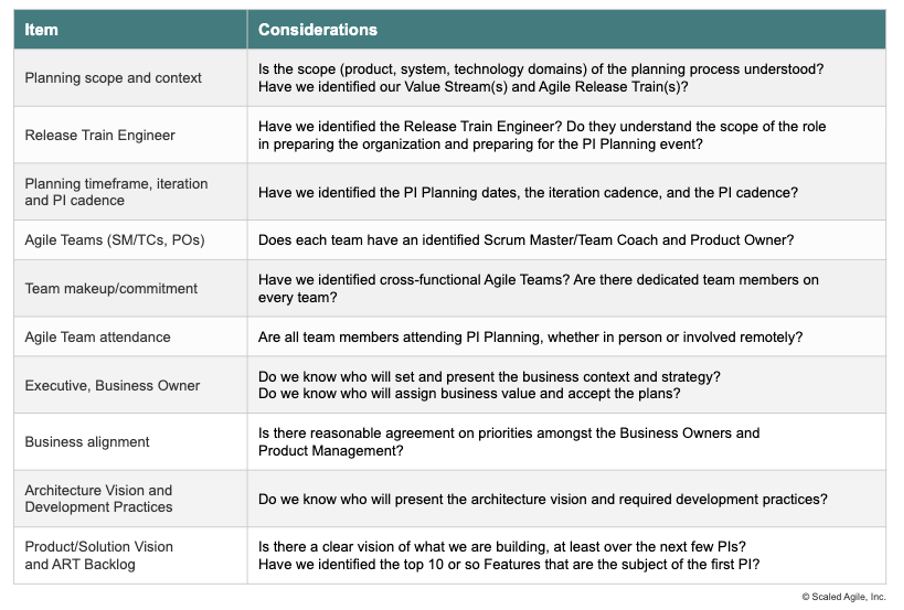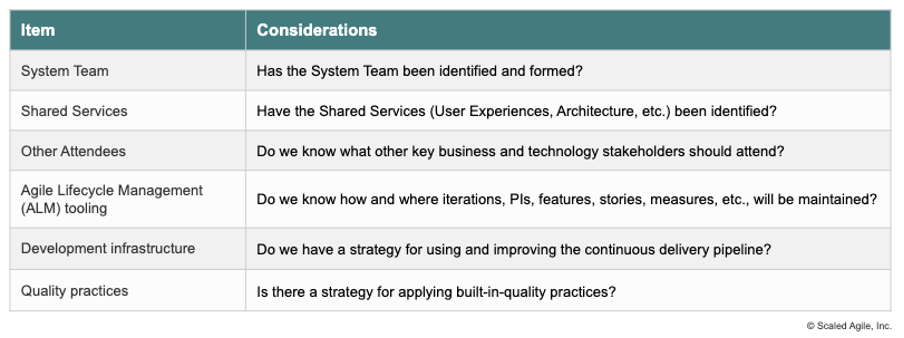PI Planning checklist
PI Planning checklist: mitigating risk and having a successful event
PI Planning is the biggest alignment event in SAFe, especially the first one. The first PI Planning, also called a forcing function, won’t be perfect—neither will PI Planning number 10 or 20. Keep in mind that you will face problems and unknowns, but make sure you prepare enough for them. One key artifact that you can use is the PI Planning Readiness Checklist. SAFe provides a very high-level list that you can check to see if you and the ART are ready for the first PI Planning event. I will get to that in a moment. Before that, when coaching people toward their first PI Planning, I like to make them think about these key areas:
- Vision and backlog
- Roles and responsibilities
- Logistics
This ensures you focus on what will be planned and how it connects to a bigger vision, that all people involved—especially RTEs, SMs, and Product Owners—know their responsibilities during the event, and that you have planned the event itself—rooms, catering, tools, and more.
What is recommended and suggested as a starting point by SAFe is the following list with needed items:

And this one with desirable items:

As you can see, some items may be quite obvious but must be checked. I’ve seen countless times that obvious items—such as having value streams—are forgotten.
As mentioned, this list contains the bare minimum to ensure we have a hypothesis ready to be tested. What I like doing is going beyond that. Especially if you are the Release Train Engineer or an SPC supporting this launch, we must pay extra attention as it’s the first time. So don’t hesitate to include in this list the obvious but essential items, such as the ART backlog, as well as more detailed ones, such as the venue, what people will eat during the event, the tools we will use, how many time zones are involved, and so on. In a recent PI Planning I was facilitating, everything was well-prepared, but we realized that five teams had breakout rooms on the same floor, while two teams had rooms on the second floor. This created a physical obstacle. What did we do? We added a checklist item to confirm with the venue that all rooms were on the same floor. So it’s also a living list that we improve and change as we move forward.
Below, you will find some ideas that I use myself in some launches:
- Team rosters finalized?
- Vanue confirmed?
- All rooms in venue on the same floor?
- Final agenda is clear with start and end, timeboxed, speakers callouts, considering different timezones?
- Communication plan stablished with message and dates?
- Invitation to PI Planning re-sent to all participants?
- Participants flights and hotels booked?
- Energizers for the event identified?
- Refreshments and meal arrangemens done?
- Rehearsal of business context, product vision and architecture vision done with speakers, feedback collected and story telling confirmed?
Now, as it is always context-dependent, I invite you to merge both lists, adding and removing what you think is necessary. The good part is that it can definitely become a checklist that can be used in future PI Plannings.
To conclude, I invite you to also check items around the following areas:
- Preparation of leadership and business owners
- Backlog and content readiness
- Team readiness
- Communication and stakeholder engagement
- Technology and tooling
